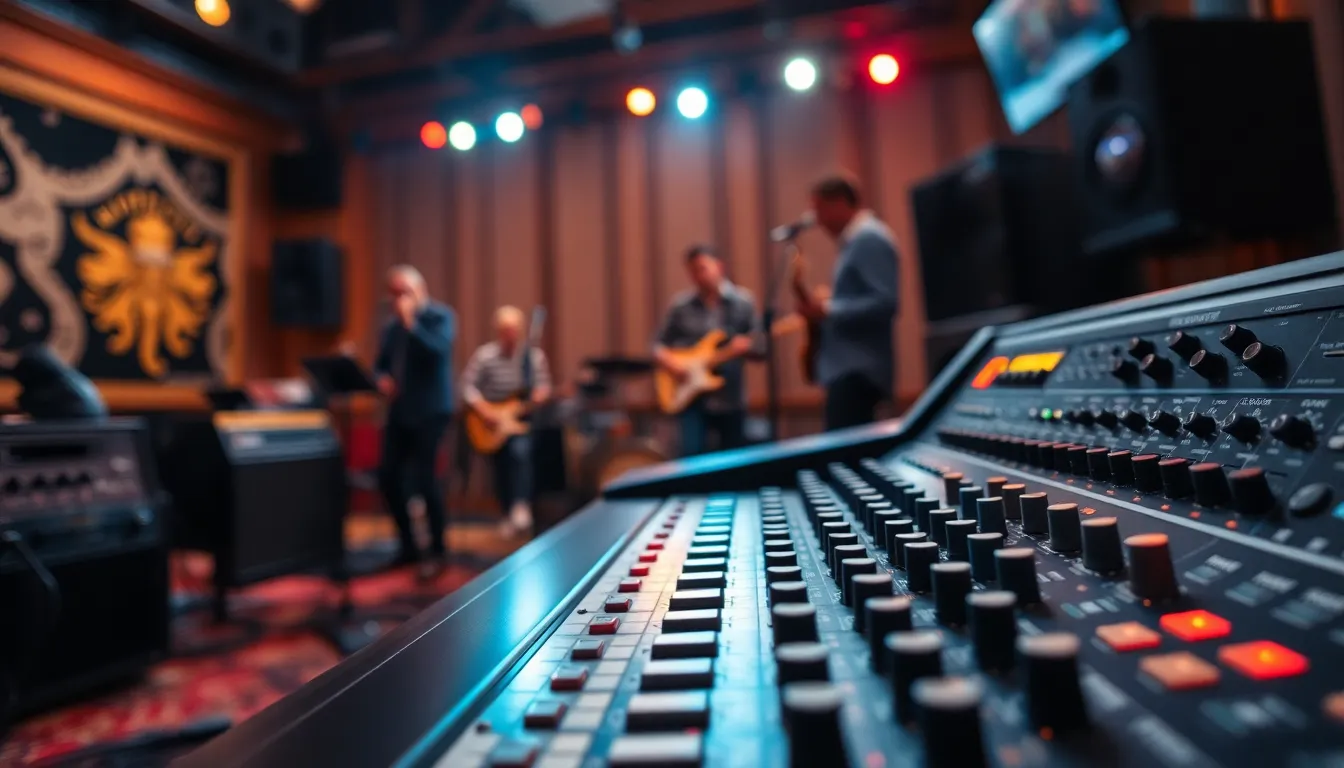In the world of music and sound, audio mixers are the unsung heroes behind every beat, melody, and podcast. They juggle multiple audio sources like a circus performer, ensuring every sound is perfectly balanced and ready to rock the house. Without them, your favorite tunes might just sound like a cat fight in a tin can.
Table of Contents
ToggleOverview of Audio Mixers
Audio mixers play a pivotal role in controlling and combining sound. These devices manage multiple audio signals, adjusting levels, panning, and equalization. Mixing consoles come in various types, including analog and digital mixers. Analog mixers utilize physical components to manipulate audio signals, while digital mixers rely on software for processing.
Many sound engineers prefer analog mixers for their warm, rich sound quality. Digital mixers, however, offer flexibility and often include built-in effects and automation capabilities. Each type serves different environments, such as live sound venues or studio recording sessions.
Setting up an audio mixer generally involves connecting microphones and instruments to the appropriate channels. Inputs then allow sound engineers to adjust levels and effects for clear sound reproduction. Most mixers feature faders and knobs for real-time control over sound characteristics, facilitating creative audio production.
Understanding audio signal flow is essential in maximizing a mixer’s capabilities. Signal flow typically starts from the sound source and moves through the mixer, with outputs directed to speakers or recording devices. Proper signal chain management ensures optimal sound quality and prevents distortion.
Mixers also incorporate auxiliary sends, which allow for creating effects like reverb or delay independent of the main mix. In many live performances, monitor mixes provide musicians their personalized sound levels. An audio mixer’s role enhances the overall listening experience by ensuring every element is perfectly balanced.
Ultimately, audio mixers form the backbone of any sound project, making them indispensable in studios and live settings alike.
Types of Audio Mixers

Different types of audio mixers serve various purposes in sound production. Understanding their features helps users choose the right one for their needs.
Analog Mixers
Analog mixers utilize electrical signals to process audio. These devices are prized for their warm, natural sound—qualities many musicians and sound engineers prefer. Users find simple interfaces on analog mixers, making adjustments straightforward. With dedicated knobs and faders, they control levels, pan, and equalization easily. However, they often lack built-in effects, placing creativity in the hands of the user. Popular among live sound applications, analog mixers deliver reliability during performances. Iconic models can manage several channels, catering to diverse setups.
Digital Mixers
Digital mixers process audio signals using digital technology. These mixers offer advanced features like onboard effects and automation, appealing to modern producers. Users benefit from flexible routing options, enabling complex setups with ease. Many digital mixers include touchscreens for intuitive manipulation, enhancing user experience. Live sound environments frequently use them due to their versatility and precise control over sound dynamics. Moreover, digital mixers allow for seamless integration with digital audio workstations (DAWs), expanding creative possibilities. Commonly seen in both studios and live venues, digital mixers shape contemporary audio production.
Key Features to Consider
Audio mixers vary in features that cater to different production needs. Notable characteristics play a significant role in a user’s experience.
Number of Channels
The number of channels in an audio mixer directly impacts its versatility. For small projects, mixers with 4 to 8 channels suffice, accommodating basic equipment like microphones and instruments. Larger productions often require mixers with 16 to 32 channels, allowing for simultaneous sound management, which is vital during live performances or complex recording sessions. A mixer with ample channels supports multiple audio sources, enhancing flexibility and creativity for sound engineers. Consideration of channel numbers ensures that the mixer aligns with specific project requirements.
Built-in Effects
Built-in effects can elevate the audio quality significantly. Many digital mixers feature effects such as reverb, delay, and compression, providing sound engineers with diverse tools for creating polished mixes. Such effects save time by eliminating the need for external processors or plugins, streamlining workflows. Users can manipulate settings in real time, adjusting parameters for desired sounds instantly. Availability of built-in effects can enhance creativity, allowing for a more expressive audio output tailored to the project’s style.
Connectivity Options
Connectivity options determine how well an audio mixer integrates with other equipment. Mixers typically include XLR inputs for microphones, 1/4-inch jacks for instruments, and USB ports for digital connections. Additional features like MIDI connections facilitate control over external devices, expanding creative possibilities. Some mixers also provide outputs for monitoring and recording, ensuring efficient signal flow. Adequate connectivity options ensure maximum compatibility, which is essential for seamless integration into various audio setups.
Choosing the Right Audio Mixer
Selecting the appropriate audio mixer plays a critical role in achieving sound quality. First, consider the number of channels an audio mixer provides. Smaller projects often require 4 to 8 channels, while larger productions benefit from 16 to 32 channels, enabling sound engineers to manage multiple audio sources effectively.
Next, evaluate the built-in effects that a mixer offers. Effects like reverb and compression enhance overall audio quality, allowing for real-time adjustments and minimizing the need for external processors. Many modern mixers also feature onboard processing, which streamlines workflows and facilitates creative sound manipulation.
Connectivity options are equally important. A mixer with XLR inputs allows for seamless integration with professional microphones, while USB ports ensure compatibility with computers and recording software. High compatibility fosters a more efficient setup, enabling sound engineers to tailor their audio environments easily.
Further, consider the type of mixer that aligns best with specific production needs. Analog mixers are favored for live settings due to their warm, natural sound and straightforward interfaces. On the other hand, digital mixers provide advanced features such as automation, flexible routing options, and touchscreen controls, appealing to contemporary producers seeking efficiency.
Lastly, think about the intended use case. A mixer for studio settings might prioritize sound clarity and stability, while a live performance mixer often emphasizes portability and ease of setup. Assessing these factors helps sound engineers select a mixer that meets their creative visions and project demands.
Popular Audio Mixer Brands
Numerous brands dominate the audio mixer market, each offering unique features and capabilities.
Yamaha ranks among the top choices for both analog and digital mixers. Known for their reliability, Yamaha mixers are widely used in professional studios and live settings. Models such as the MG series provide excellent sound quality and intuitive controls.
Behringer offers a broad range of affordable mixers tailored for beginners and experienced users. Their XENYX line features built-in preamps and equalization, appealing to various sound projects. Many musicians prefer Behringer for their cost-effective yet high-performing solutions.
Mackie stands out with their durable construction and user-friendly design. The Mix series, for instance, features compact mixers with robust functionality. Mackie’s products are particularly popular in live performances due to their reliable performance.
Soundcraft is known for its innovative digital mixers that incorporate advanced technology. The Signature series combines classic analog sound with modern digital features, making it versatile for studio and live use. Many users appreciate Soundcraft for seamless integration in various audio setups.
Alesis appeals to home recording enthusiasts with its budget-friendly digital mixers. Their MultiMix line provides essential features without overwhelming complexity, making it ideal for small projects.
Allen & Heath specializes in high-end mixers favored by professionals. The SQ series delivers exceptional sound quality and extensive routing options, catering to advanced sound engineers. Those looking for superior audio performance often choose Allen & Heath.
PreSonus combines affordability with cutting-edge technology in their digital mixers. The StudioLive series features built-in recording capabilities and wireless control via an app, appealing to modern producers. Many appreciate PreSonus for its ability to streamline workflow in a variety of settings.
Selecting a brand often depends on specific needs, budget, and intended use, ensuring the right mixer enhances audio production experiences.
Audio mixers play an essential role in shaping sound across various platforms. Their ability to balance and enhance audio signals ensures that music and podcasts resonate with clarity and depth. Whether opting for the warm tones of an analog mixer or the advanced features of a digital counterpart, selecting the right mixer is crucial for achieving desired sound quality.
With a multitude of brands and models available, sound engineers can find mixers tailored to their specific needs. By considering factors like channel count built-in effects and connectivity options, they can enhance their production capabilities. Ultimately the right audio mixer not only elevates sound quality but also empowers creativity in music and sound production.

